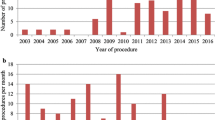Abstract
Purpose
Post-operative seizure rates after endoscopic third ventriculostomy (ETV) are not definitively known. We analyzed our institution’s experience for all causes of hydrocephalus in pediatric patients undergoing ETV to determine rates of post-ETV seizure.
Methods
A retrospective review of institutional pediatric patients undergoing ETV from May 2014 to December 2018. Included were < 21 years, with 1-year follow-up. Exclusion criteria included ventriculoperitoneal shunts (VPS) prior to ETV, VPS within 7 days post-ETV, and prior seizure disorder. Data included age, gender, diagnosis, early post-operative seizure (within 7 days post-ETV), late post-operative seizures (after first 7 days and within first year post-ETV), concomitant choroid plexus cauterization (CPC), VPS conversion within 1 year, and administration of prophylactic antiepileptics.
Results
Sixty of 81 ETV cases were included; 41% underwent concomitant CPC. Of these, 53% (n = 32) were male, 46% (n = 28) female, averaging 5.8 years, with the most common diagnosis neoplasm-related obstructive hydrocephalus (38.3%, n = 23). Early post-operative seizure occurred in 6.7% (n = 4); late post-operative seizure occurred in 8.3% (n = 5). Late post-operative seizures were higher in patients experiencing early post-operative seizure versus those without (75% vs 3.7%, p = 0.003). Late post-operative seizure occurred in 13.6% (n = 3 patients) requiring VPS versus 5.3% (n = 2 patients) with successful ETV (p = 0.36). Rates did not correlate with pathology. No patients received prophylactic antiepileptics prior to surgery or exhibiting a seizure.
Conclusions
Patients with early post-operative seizures have an increased likelihood of developing late post-operative seizures. Pediatric ETV patients may have a lower rate of both early and late post-operative seizure; underlying pathology may influence these rates.

Similar content being viewed by others
Abbreviations
- CSF:
-
Cerebrospinal fluid
- CPC:
-
Choroid plexus cauterization
- EEG:
-
Electroencephalogram
- ETV:
-
Endoscopic third ventriculostomy
- VPS:
-
Ventriculoperitoneal shunts
References
Dan NG, Wade MJ (1986) The incidence of epilepsy after ventricular shunting procedures. J Neurosurg 65:19–21. https://doi.org/10.3171/jns.1986.65.1.0019
Graebner RW, Celesia GG (1973) EEG findings in hydrocephalus and their relation to shunting procedures. Electroencephalogr Clin Neurophysiol 35:517–521. https://doi.org/10.1016/0013-4694(73)90028-x
Venes JL, Dauser RC (1987) Epilepsy following ventricular shunt placement. J Neurosurg 66:154–155. https://doi.org/10.3171/jns.1987.66.1.0154
Klepper J, Büsse M, Strassburg HM, Sörensen N (1998) Epilepsy in shunt-treated hydrocephalus. Dev Med Child Neurol 40:731–736. https://doi.org/10.1111/j.1469-8749.1998.tb12340.x
Bourgeois M, Sainte-Rose C, Cinalli G, Maixner W, Aicardi J (2018) Epilepsy in childhood shunted hydrocephalus. In: Cinalli G, Ozek M, Sainte-Rose C (eds) Pediatric hydrocephalus. Springer, Cham, pp 1–20
Schubert-Bast S, Berghaus L, Filmann N, Freiman T, Strzelczyk A, Kieslich M (2019) Risk and risk factors for epilepsy in shunt-treated children with hydrocephalus. Eur J Paediatr Neurol 23:819–826. https://doi.org/10.1016/j.ejpn.2019.09.004
Punchak M, Mbabazi Kabachelor E, Ogwal M et al (2019) The incidence of postoperative seizures following treatment of postinfectious hydrocephalus in Ugandan infants: a post hoc comparison of endoscopic treatment vs shunt placement in a randomized controlled trial. Neurosurgery 85:E714–E721. https://doi.org/10.1093/neuros/nyz122
Kulkarni AV, Riva-Cambrin J, Holubkov R et al (2016) Endoscopic third ventriculostomy in children: prospective, multicenter results from the Hydrocephalus Clinical Research Network. J Neurosurg Pediatr 18:423–429. https://doi.org/10.3171/2016.4.PEDS163
Kulkarni AV, Riva-Cambrin J, Rozzelle CJ et al (2018) Endoscopic third ventriculostomy and choroid plexus cauterization in infant hydrocephalus: a prospective study by the Hydrocephalus Clinical Research Network. J Neurosurg Pediatr 21:214–223. https://doi.org/10.3171/2017.8.PEDS17217
Riva-Cambrin J, Kestle JRW, Rozzelle CJ et al (2019) Predictors of success for combined endoscopic third ventriculostomy and choroid plexus cauterization in a North American setting: a Hydrocephalus Clinical Research Network study. J Neurosurg Pediatr:1–11. https://doi.org/10.3171/2019.3.PEDS18532
Merkler AE, Ch’ang J, Parker WE, Murthy SB, Kamel H (2017) The rate of complications after ventriculoperitoneal shunt surgery. World Neurosurg 98:654–658. https://doi.org/10.1016/j.wneu.2016.10.136
Tully HM, Kukull WA, Mueller BA (2016) Clinical and surgical factors associated with increased epilepsy risk in children with hydrocephalus. Pediatr Neurol 59:18–22. https://doi.org/10.1016/j.pediatrneurol.2016.02.011
Acknowledgements
The authors appreciate the assistance of Sharon Durfy, PhD, with manuscript preparation.
Author information
Authors and Affiliations
Corresponding author
Ethics declarations
Conflict of interest
Dr. Hauptman reports he is a consultant for Medtronic, unrelated to work described in this research. All other authors report no conflict of interest.
Additional information
Publisher’s note
Springer Nature remains neutral with regard to jurisdictional claims in published maps and institutional affiliations.
This study was accepted for an International Society of Pediatric Neurosurgery Poster/Talk.
Rights and permissions
About this article
Cite this article
Barkley, A.S., Boop, S., Barber, J.K. et al. Post-operative seizure after first time endoscopic third ventriculostomy in pediatric patients. Childs Nerv Syst 37, 1871–1875 (2021). https://doi.org/10.1007/s00381-021-05078-y
Received:
Accepted:
Published:
Issue Date:
DOI: https://doi.org/10.1007/s00381-021-05078-y




